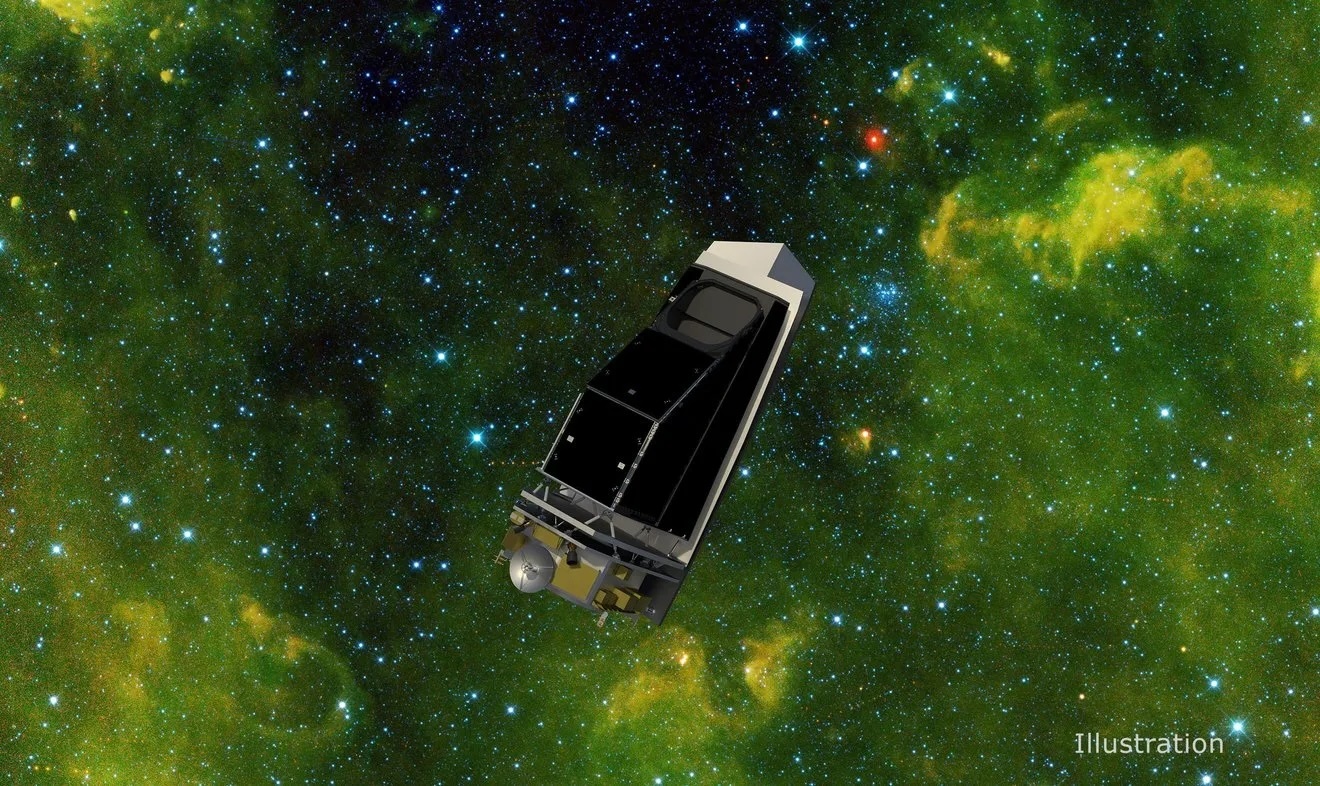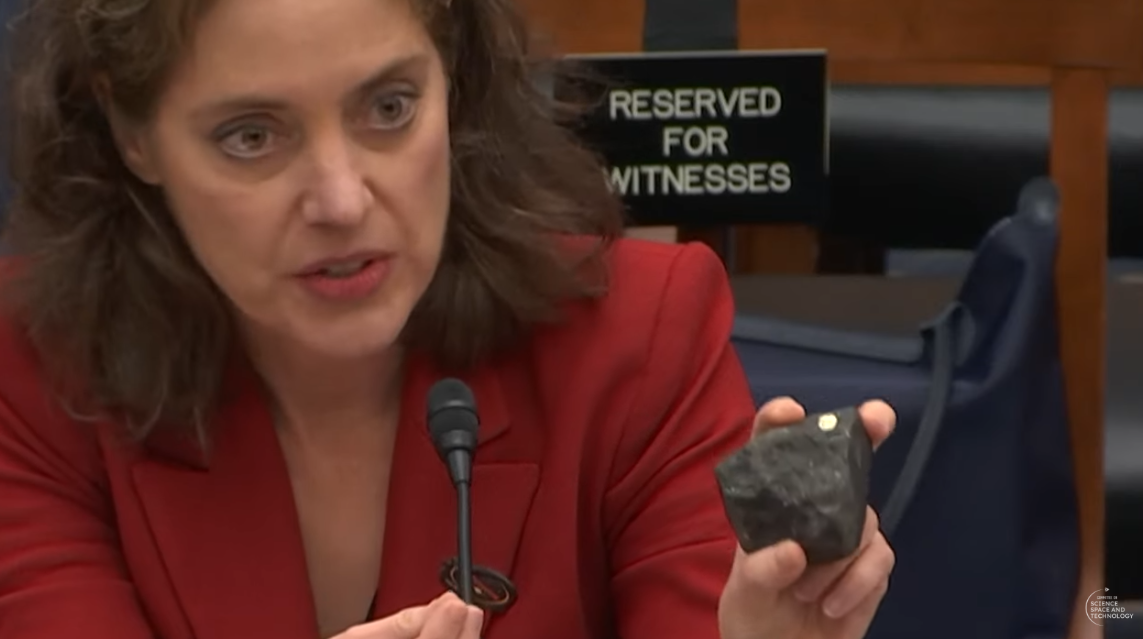28.01.2023
NEO Surveyor launch delayed despite funding boost

While Congress added $50 million to the $40 million NASA requested for NEO Surveyor in fiscal year 2023, that additional funding will not prevent a slip in its launch from 2026 to 2028. Credit: NASA/JPL
WASHINGTON — While Congress provided more funding than NASA requested for an asteroid mission, agency officials said it will not prevent a two-year slip in its launch.
The fiscal year 2023 omnibus spending bill enacted in December directed NASA to spend no less than $90 million on the Near Earth Object (NEO) Surveyor mission, a space telescope to detect near Earth asteroids as part of NASA’s planetary defense efforts. NASA had requested only $39.9 million for the mission in its budget request, far less than previously projected, and said it would delay the mission’s launch from 2026 to 2028.
At a Jan. 24 meeting of NASA’s Small Bodies Assessment Group (SBAG), Lori Glaze, director of NASA’s planetary science division, said that while the additional funding was helpful, it would not allow NASA to avoid that delay.
“They had a really tough budget for 2023, but, luckily, the appropriations for NEO Surveyor actually gave them an extra $50 million,” she said. “It’s not enough to put them back on schedule for a 2026 launch. We’re still looking at 2028, officially, but it’s a huge help in getting that team moving forward.”
Congress passed the spending bill weeks after the mission passed a confirmation review, formally known as Key Decision Point C, allowing it to go into its next phase of development. That review formally set a target launch date of no later than June 2028 and a cost estimate of $1.2 billion.
“We’re past confirmation and into Phase C,” Amy Mainzer, survey director for NEO Surveyor, said in a separate presentation at the SBAG meeting Jan. 24. “It’s really great to be able to say that.”
She said that the mission is currently working towards a launch in September 2027, nine months ahead of its formal requirement. The project is making good progress on the infrared camera that the spacecraft will use to detect near Earth objects, with a goal of finding two-thirds of such asteroids at least 140 meters across in five years.
Mainzer briefly addressed the budget issues NEO Surveyor faced. That included not just the cut in NASA’s 2023 budget request but also the agency’s decision in June 2022 to rescind $33 million of the $143 million appropriated in fiscal year 2022, redirecting that funding to other projects. By the end of August 2022, NASA told the project to plan to have $80-90 million in fiscal year 2023 based on the progress of congressional appropriations.
“We did suffer some budget cuts, it’s true, but we’re moving on,” she said. “We did manage to make very good use of the funds that we have available this year.”
Both Glaze and Mainzer addressed at the SBAG meeting another concern about the mission: its increased cost. NEO Surveyor is a version of a mission concept called NEOCam that was a finalist in NASA’s Discovery program of low-cost planet science missions, and as recently as 2019 was projected to cost no more than $600 million. The new $1.2 billion cost estimate took some in the planetary science community by surprise.
“I will take ownership for that because of the delays that we put in place and some of the budget challenges that we imposed on the mission,” said Glaze. The two-year delay, she noted, addressed budget pressures in the near term but increased the mission’s overall cost by stretching it out.
Mainzer looked at the big picture, noting the mission’s goal of identifying any asteroids that might pose a serious impact risk to the Earth. “This is a problem we know how to solve. How many global problems do we know how to solve that are of the order of $1 billion?” she said. “It’s an important thing to do.”
Quelle: SN
----
Update: 23.02.2025
.
NASA selects SpaceX to launch NEO Surveyor

NASA's NEO Surveyor spacecraft will look for near Earth objects. Credit: NASA
WASHINGTON — NASA picked SpaceX for the launch of a space telescope dedicated to searching for near Earth objects.
NASA announced Feb. 21 it awarded a task order through the NASA Launch Services II contract for the launch of the Near Earth Orbit (NEO) Surveyor spacecraft on a Falcon 9. That task order is valued at approximately $100 million, the agency stated.
NEO Surveyor will launch on a Falcon 9 from Florida as soon as September 2027. It will operate from the Earth-sun L-1 Lagrange point, 1.5 million kilometers from Earth in the direction of the sun.
The spacecraft will feature a telescope 50 centimeters in diameter equipped with infrared detectors. That instrument will allow NEO Surveyor to detect near Earth objects and determine both their orbits and their sizes. The mission has a goal of detecting two-thirds of the NEOs at least 140 meters across in five years, and a congressionally mandated goal of 90% of such objects in 10 to 12 years.
The launch contract came just after the $1.2 billion mission passed its critical design review Feb. 6. That allows NEO Surveyor to move into the next phases of assembly and testing. Part of the spacecraft, called the instrument enclosure, is undergoing environmental testing at the Johnson Space Center. Later this spring, that and other sections of the spacecraft will go to the Space Dynamics Lab in Utah to integrate other components and perform more testing.
The importance of searching for NEOs was highlighted by recent attention surrounding one such asteroid, 2024 YR4. The asteroid, discovered in December, is estimated to be between 40 and 90 meters across, and initial calculations of its orbit showed it had a small but non-zero chance of hitting the Earth in December 2032.
Additional observations resulted in the chance of an impact growing to 3.1% by Feb. 18. Subsequent observations, though, have further refined its orbit and caused the risk of an impact to fall dramatically. As of Feb. 21, the Center for Near Earth Object Studies at the Jet Propulsion Laboratory calculated only a 0.36% chance of an impact in December 2032.
Quelle: SN
----
Update: 16.05.2025
.
NASA’S ASTEROID-HUNTING TELESCOPE ON TRACK FOR 2027 LAUNCH
Earth-threatening asteroids have been in the news recently and Congress is paying attention. At a House hearing today, they got the good news that NASA’s NEO Surveyor asteroid-hunting telescope is ahead of schedule. Launch is expected in late 2027, several months earlier than the date NASA committed to several years ago. Broad bipartisan support for planetary defense — protecting Earth from potentially hazardous asteroids — was on full display at the hearing, though concerns were raised about the future of NASA’s space science program under the skinny budget proposed by the Trump Administration.
The House Science, Space, and Technology Committee has a long standing interest in locating and tracking asteroids and comets — jointly referred to as Near Earth Objects or NEOs — that might pose a threat to Earth. In 1995 under the leadership of Rep. George E. Brown (D-CA), the committee spearheaded legislation that directed NASA to find 90 percent of NEOs one kilometer or more in diameter within 10 years. NASA did that and in 2005 the committee crafted legislation asking them to find 90 percent of NEOs 140 meters or more in diameter within 15 years, naming it the George E. Brown, Jr. Near-Earth Object Survey Act in honor of Brown, who passed away in 1999.
NASA didn’t meet that deadline. After 20 years, only 44 percent of the estimated number of NEOs of that size have been located. Finding those smaller asteroids is difficult. Many of them are dark and spotting them visually is a challenge. In addition, the telescopes looking for them are on Earth with a limited field of view. The solution is a space-based infrared telescope designed to search for their heat signatures.

NEO Surveyor lead Amy Mainzer shows House Science, Space, and Technology subcommittee members an asteroid fragment (meteorite) to demonstrate how optically dark many of them are and thus difficult to find visually. Screenshot. May 15, 2025. Screenshot.
NEO Surveyor is that space telescope. The project’s lead, Dr. Amy Mainzer of the University of California Los Angeles, testified today to the House SS&T Space and Aeronautics Subcommittee that once NEO Surveyor is deployed, it will be able to reach the 90 percent target within 10-12 years.
Otherwise NASA has said it will take at least 30 years.

NASA’s commitment to Congress in 2022 was that NEO Surveyor would launch by June 2028, but it’s ahead of schedule. Mainzer said they plan to launch in late 2027.
The telescope is being built at the Jet Propulsion Laboratory in Pasadena, CA and the January fires there came very close to JPL. The lab was closed while JPL and local firefighters successfully fought to keep it safe. Fox proudly said that despite all of that, NEO Surveyor suffered only a one-month delay. “That does put the telescope on the critical path,” but she did not seem overly concerned.
Subcommittee chairman Rep. Mike Haridopolos (R-FL) noted that a July 2023 Pew Research Center survey found that 60 percent of respondents said NASA’s top priority should be monitoring asteroids or other objects that could hit Earth, “the largest share among any category surveyed.”
The discovery of asteroid 2024 YR4 at the end of December 2024 reignited public and congressional interest in the dangers posed by asteroids after initial estimates concluded it had a better than 1 percent chance of impacting Earth in 2032.
Asteroids are rocks in space left over from the formation of the solar system and vary in size and composition. Over a million asteroids are floating around the solar system. Many are in a belt between Mars and Jupiter and do not come close to Earth, but others do. Those are the ones planetary defense scientists around the world are trying to locate and track.

The Minor Planet Center at the Smithsonian Astrophysical Observatory is the hub where amatueur and professional observers send their data. Matthew Payne, Director of the Minor Planet Center, testified today that they process more than 50 million observations from 2,600 observatories in 80 countries each year and track the orbits of the 38,000 known NEOs including more than 2,400 Potentially Hazardous Objects.
2024 YR4 was one of them. First detected by the NASA-funded Asteroid Terrestrial-impact Last Alert System (ATLAS) telescope in Chile on December 27, 2024, it rose on NASA’s automated Sentry risk list on December 31 because it had a greater than 1 percent chance of hitting Earth.
That’s the threshold for when NASA is required to notify other U.S. government agencies and the International Asteroid Warning Network notifies the United Nations Office of Outer Space Affairs, which disseminates the information to U.N. member states. Nicky Fox, NASA Associate Administrator for the Science Mission Directorate, told Haridopolos this was the first time those procedures were exercised.
Fortunately, as 2024 YR4’s orbit became better refined after additional observations, the chances of it hitting Earth dropped to near zero. Fox said there still is about a 1 percent chance it may hit the Moon, however.
Another asteroid that’s getting a lot of attention is Apophis, which will pass very close to Earth on April 13, 2029. Scientists are certain it will not hit the planet, but its close approach of 32,000 kilometers, about the altitude where geostationary satellites orbit the Earth, provides a unique opportunity for ground-based telescopes to get a close look.
Scientists also want to study it from space before and after it passes Earth to see how it changes. NASA has repurposed an existing spacecraft, OSIRIS-Rex, which brought back samples from the asteroid Bennu in 2023, to catch up with Apophis after it passes Earth. The samples were in a capsule that separated from OSIRIS-REx; the main spacecraft is still in space. Renamed OSIRIS-APEX, it will spend 18 months studying Apophis.
The European Space Agency is building a dedicated satellite, RAMSES, to observe Apophis before it gets to Earth, but today Fox revealed that OSIRIS-APEX also will be able to get images about two weeks before Apophis gets here. They’ll be low resolution, but “we’re going to have some really nice images of how the light and the brightness changes.”
NASA’s Planetary Defense Coordination Office (PDCO), part of the Science Mission Directorate, has broad bipartisan support. Several members praised PDCO’s 2022 Double Asteroid Redirection Test (DART)when a NASA spacecraft deliberately impacted a small asteroid, Dimorphos, that orbits a larger one, Didymos, and changed its orbit. As Fox said it was “the first time humanity had moved a celestial body in space, and it proved that an asteroid impact is a natural disaster that humans could prevent with enough warning time.”

Some subcommittee members were concerned about funding for PDCO and the rest of NASA’s science portfolio following release of the Trump Administration’s skinny budget on May 2 that calls for a 24 percent cut to NASA.
Subcommittee Ranking Member Valerie Foushee (D-NC) said today’s hearing “would be a natural continuation” of the committee’s oversight of the planetary defense program, but the situation is “far from ordinary.” The budget proposal includes a “staggering 47 percent cut” to NASA’s science portfolio and overall would “strip away NASA’s storied leadership, disrupt decades of progress in U.S. space exploration and cripple the agency’s ability to pursue bold and ambitious goals going forward. That would be a sad and hollow future for our civil space program.” Other Democratic members also criticized deep cuts proposed for other government science agencies.
The skinny budget provides only top-line numbers, not details. The full request is expected in June. Fox said she doesn’t know what that request will say. For now SMD is spending FY2025 funding “in accordance with the law.”
Asked why she delayed issuing the next Research Opportunities in Space and Earth Science (ROSES) solicitation for research grants to the science community, Fox said she wanted to wait for the skinny budget to be sure SMD would be able to support it. She didn’t want people spending time writing proposals and then having to withdraw it. She now expects to issue it “as early as the end of this month.”
Quelle: Space and Technology Policy Group, LLC
